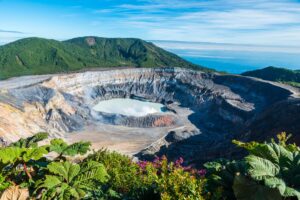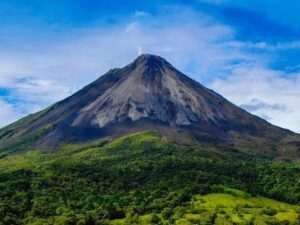Anh Huynh. May 05 2023
When talking about Costa Rica, there are many amazing things coming to mind such as food, nature, food, people, and not to forget, volcanoes. There are currently 6 active volcanic sites and 61 dormant or extinct ones. An active volcano is currently erupting, or is one that has erupted in historic time. There are five active volcanoes in Costa Rica: Turrialba Volcano, Poas Volcano, Arenal Volcano, Rincón de la Vieja Volcano, and Irazu Volcano A dormant volcano is not erupting now, but is considered likely to erupt in the future. Tenorio volcano is considered dormant. Extinct volcanoes are those which have not erupted in human history. These volcanoes are sites that attract thousands of tourists every year, stimulating economics and hospitality activities. People come here to enjoy hot springs, magnificent nature and views, canyon, kayak, and many more. Here, this is where people from all over the world know and learn more about Costa Rica as a hub of volcanoes and natural wonders.

Poás. Source: Horizon Guides.

Arenal. Source: Travel Excellence.
The Critical Zone (CZ) is defined as an Earth’s permeable near-surface layer, which represents the interface between atmospheric layer and deep earth. This is an area where rock, soil, water, air, and living organisms interact. These complex interactions control the natural habitat and are responsible for the availability of life-sustaining resources, such as water, food, and agriculture production. Thick CZ in these regions can be advantageous for human daily life activities such as farming, mining, lumber, water storage for consumption, and renewable energy generation. Materials expelled by volcanoes can become fertile soils in a relatively short time which can be beneficial for human settlements, or can be utilized as constructions materials source. An article wrote that re-Hispanic inhabitants of the northern Poás area, for instance, utilized the local geomorphology as a natural defense against pre-Hispanic volcanic activity. Costa Rica’s more developed pre-Hispanic cultures demonstrate that they possessed a grasp of hazard prevention and mitigation as evidenced by minor modifications in site location when volcanic activity subsided.
It is crucial to regularly investigate and research the depth and height and the condition of CZ in volcanic areas due to the nature of frequent changes of these areas. Under these conditions, humans and CZs in volcanic regions are not only interacting but mutually evolving and becoming resilient together. It is important to understand the relationship between the natural action and human intervention around the areas so that transformation and adaptation can be established for the time being. In the past, after the Irazu eruption, most of Costa Rica’s prime agriculture and some significant cities, including the country’s capital San Jose, which is only around 20 miles from the crater, were coated in volcanic dust. The dust, which was three feet deep in some areas, collapsed roofs, adhered to the sticky coffee tree leaves and killed them, smothered cattle, and poisoned them. Nowadays, that it is dormant, the volcano is a behemoth that even Taras’s residents generally overlook. Buses transport tourists to its desolately serene top. Along Irazu’s lush green hills, dairy cows graze next to cottages in the Swiss style.Some farmers think the soil has actually benefited due to the sandy volcanic ash’s better drainage. The stones that played a significant role in Taras’ destruction are currently employed in regional buildings.
However, not everyone is as relaxed. Engineer Jorge Manuel Dengo, who oversaw Costa Rica’s response to the Irazu disaster, recalls how unprepared the country was for such a severe blow. He worries that the tragedies of Irazu might be repeated despite the government’s and universities’ best attempts to monitor the nation’s volcanic activity.
Despite continuous and consistent effort to monitor volcanic activity, tremendous and deadly surprises could happen. There are, indeed and hopefully, positive sides such as the potentiality of geothermal energy and tourist attractions. Both fears and hope run on a daily basis among the residents and experts in Costa Rica, a land of unbidden volcanoes.
Sources:
1: https://costarica.org/volcanoes/
3: https://www.summitpost.org/costa-rica-volcanoes/180570
4: https://www.washingtonpost.com/archive/politics/1980/06/02/costa-rica-lives-with-volcano-threat/f64f8f9d-757c-4dce-bad7-e637bff53a72/
Images:
Póas: https://horizonguides.com/guides/costa-rica-national-parks/poa%CC%81s-volcano-national-park
Arenal: https://www.travelexcellence.com/costa-rica-top-destinations-travel-guides/arenal-volcano-national-park-la-fortuna-vacations/